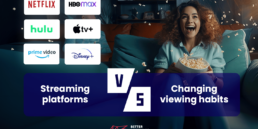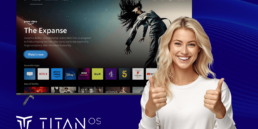Following the outbreak of COVID-19, many countries have introduced various measures to tackle the pandemic. Social isolation has definitely protected public health by reducing people’s exposure to the virus and minimizing its transmission.
The imposed social isolation is a great opportunity for the education sector to fully realize and investigate the use of video platforms in teaching. Whether you are a student, teacher, or an institution, it’s high time to get on board with the technology, and this post, hopefully, will catch you up with the benefits.
The benefits of video for the students
There is strong evidence confirming that the use of video in education is not only convenient but also benefits the students, supporting the learning processes.
Videos are great for complex concepts
Visual stimulation encourages student interaction with content, which works especially well for complex concepts. Whether primary or complementary, video materials lend well for explaining various ideas or procedures in engineering, technology or science, and math formulas. Videos can closely follow people’s natural thought processes.
Videos better accommodate shorter attention spans
Much thanks to YouTube’s standards, people have grown to expect educational and instructional videos to be not longer than 15 minutes. This should be remembered when developing class videos – a half-an-hour video should not be broadcast in one sitting.
Depending on the student’s age, the average attention span is 7-15 minutes. Knowing this, videos can not only be produced in a way makes the best use of the timeframe without sidetracking or digressing. At the same time, it changes the role of the teacher, who serves more as a facilitator – stopping when necessary, fostering understanding and answering students’ questions.
Videos favor comprehension, retention and engagement
It’s no secret that students are better at processing and remembering the things they like, and it’s no secret that digital natives prefer video to text. To foster the process, students can pause or skip throughout the video, and stop to have engaging in-class discussions or review the information.
Video educational content, when properly made, creates a bigger imprint in a student’s mind and boosts achievement. A recent study revealed that video education increased student achievement levels in 88 percent of surveyed universities. San Jose State University discovered that students attending flipped classrooms, i.e. watching video lectures before attending classroom discussions achieve better scores by 10 to 11 points.
Since videos include both video and audio, they stimulate two information processing channels. This helps learners build more powerful associations and memorize things better.
Video is the language of digital natives
Many digital-native students may simply not find traditional textbooks attractive enough. They’ve grown learning almost every skill from YouTube or Udemy, whether it was cooking, knitting, drawing, programming, playing an instrument or repairing a laptop. Nowadays, many people simply expect all knowledge to be transferred and ingested in the form of video.
This is partly due to better accessibility of video content. Videos can be watched from anywhere in the world provided there is an internet connection. Students can access the content using a multitude of devices – laptops, tablets, or phones. This allows for viewing at the student’s convenience and from wherever they are.
Videos allow adapting the pacing of the lecture to each student’s preferences
For many students, the ability to adjust the playback speed, skip unimportant parts, or simply stop the video while taking notes is the key allure. But that’s not all. Students can also choose the optimal time of day to learn. Early birds can pick the course in the morning, while night owls will prefer to do it at night.
Benefits for the teachers
Video education platforms are not only better appeal to modern-day students than traditional textbooks. They are also powerful tools in the hands of teachers. They make their work more effective and better suited to the needs of students.
By using video platforms, teachers can save a lot of time and make sure no important information slips. But that’s not all. For example, the idea of a flipped classroom removes the repetitive information that students can watch before class. This allows teachers time to focus on practice and skill development activities which require a little more interaction with each student.
Useful analytics
Backed by the video platform and analytics, teachers can better track student engagement and use the information to refine their content – something not possible in traditional classrooms.
Video classes can incorporate student feedback, attendance and engagement to better address more difficult problems, iterate and produce improved versions of the lectures.
With today’s technology, there is no guessing. You can track what percentage of the video was actually watched, and when users switched to a different tab.
Instead of presentation, teachers can focus on facilitating understanding
The most common concern about videos in education is that they aim to replace the teacher. But this understanding is flawed, much like a fear that machines will take other human jobs. People will still be needed to create and deliver value, albeit in completely unheard of ways.
This being said, videos can be used to slightly alter the role of the teacher from lecturer to facilitator. It’s important to note that videos are meant to enhance courses and lectures, and not to put teachers out of their jobs.
Most good educational videos come in smaller modules, accommodating students’ shorter attention spans.
The benefits of video for the school or university
Videos can also serve to promote the school. For example, a short video tour of the campus can speak a thousand words, making a huge difference to the students trying to figure out which school to choose. But this is just a taste of what’s possible.
Showcase your amazing staff
Some teachers have amazing, infectious personalities. Their presence alone can inspire and motivate students, and their voice can resonate in such a way that makes listening to them a real treat, and an amazing experience. But these features never transpire through the bland paragraphs of your school’s “about us” section.
This is where video comes in handy. You can make virtual guided tours of the campus, offer interactive maps, and present your teachers. This is especially important for students who are unable to visit in person.
More efficient staff onboarding and training
Schools often need to assemble their faculty and staff at the same time in one place just to relay information. This is incredibly inefficient. Proper video presentations not only improve their retention and recall, but also serves as an archive to review it any time.
Record important events for future viewing
Video can also be used to foster relationships with parents, students and alumni and let them know what’s going on at your school. In this way they’ll feel more invested, and possibly more likely to recommend the school to friends and relatives.
Such accessibility through videos builds better relations with parents, candidates and alumni. From a purely marketing point of view, such openness can also attract future students.
Ability to increase online course offerings
Enabling video clips to be easily uploaded to a video platform and then downloaded by the students provides an additional valuable resource. Using video to build a solid online program can greatly enhance your appeal to potential online students.
No limit to the number of students
Education using video platform is a way to reach broader audiences as video classrooms are not limited by the number of seats or tables. They can take an almost unlimited number of students without actually compromising anyone’s experience.
At the same time, great lectures can go viral and serve as a great trademark for your school.
Last words
It’s only a matter of time before most universities offer video courses to adapt to the needs of the market. Adopting the use of video platforms in education at an earlier age improves digital literacy and communication, which are among the most important skills of the 21st century. Digital literacy can no longer be seen as a concept completely separate from education, but as of the most important life skills needed to thrive in the modern world.
The coronavirus situation threw a spanner in the works for many businesses and institutions, but also accelerated the adoption of various remote working tools and video platforms.
Among other institutions, schools and universities have also been forced to switch to all-remote mode as a way to continue providing services. This gave us a glimpse of the future – but that’s only the beginning. Video platforms will soon be integral in education, and give schools a way to differentiate on the market.
If you find this article valuable, you can share it on social media →
Read more about the VOD & OTT Industry!
March 7, 2024
7 reasons why is sports streaming becoming so popular
Learn more about the reasons why sports streaming is becoming more and more popular right now.
February 29, 2024
Why should streaming platforms adapt to changing viewing habits?
Discover the strategies through which streaming platforms adjust to changing viewing habits.
February 20, 2024
What is Titan OS and what do we know about it so far?
Explore what distinguishes Titan OS, a new smart TV operating system. Discover its unique features before giving it a try yourself.
Are you looking for a partner to build a Video Solution?
Leave your email and a short description about your project. We would gladly discuss different cooperation possibilities!





